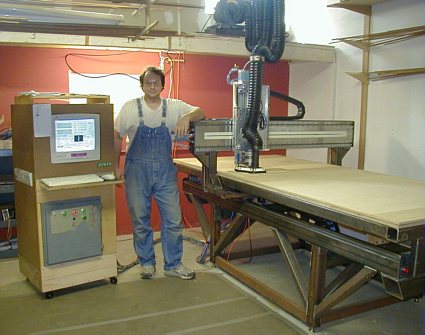
 |
MadVac CNC - a precision, 4'x8'
gantry router designed and built from scratch- controller and all. A little
paint job and this "ugly duckling" is a beauty. |
|
Index of pages:
A few random thoughts and reflections about the project: The research, design and planning of every component, materials and aspect of this machine took about one full year and the construction itself started in Jan 2004 and was 95% finished in July 2004. Virtually all insight and information about "cnc" came from various sources on the Internet such as manufacturer on-line catalogs, discussion groups and individual web pages. One may legitimately ask, why one would be so crazy to attempt building a large cnc machine instead of just buying one. The initiative to build this thing came mostly from the realization that I would end up with a multipurpose machine that would open up doors of all kinds of opportunity and in being able to mass produce things in the near future that I needed/wanted for my work (already had a long list of items that could use a cnc treatment). Next, came the obvious obstacle of not having thirty plus grand lying around to plunk down for some else's creation. It is one thing to have products and a production schedule ready for the machine so that is starts paying for itself immediately, but having no such thing, the pay as you go route was a better, less stressful alternative. Least but not last, this was a technical challenge I just could not resist and a very fulfilling and addictive hobby to boot (here is the test: if your regular bed time and bathroom library reading consists of Enco, MSC and McMaster catalogs and other technical literature and you would classify your personality as "obsessive-compulsive", you are on the right path and have a better than average chance of success ;)). One thing is for certain, it is a leap of faith to "see" the whole thing finished while you are at step one of a hundred thousand step process. You have some concept of the work flow in your head but you do not really "know" every step in every detail. You just know ahead of time there will be some ideas that will turn into time wasting dead ends (so typical of first time projects) so you will have to find alternatives that you have not possibly thought about yet and you pray that these obstacles will not stop you dead in the tracks (well, at least not for thousands of additional $$$). About half way through, you will realize that you are actually undertaking the equivalent of an "Iron Man" endurance race in machine building and there is no way back with thousands of dollars burnt up already, and there is still very little to show for your effort. Why? The thing about precision machinery (not a drawer slide/ heating pipe CNC) is that everything you do will require some holding or alignment "jig" that has to be invented and made along the way (or at least painstakingly set up) before you can drill this or attach that on the machine. Working without nicely equipped machine shop (mill, lathe, bench grinder, column drill) as in my case adds lots extra points to the "elbow grease" coefficient. Anyway, having been inspired by amateur hobbyists that were building these machines (albeit smaller - about the size of my y axis) I sat down, drew up some initial 3D sketches in CAD and begun researching the components needed to get started. The first thing you encounter when designing such machine from scratch is the sudden almost paralyzing avalanche of "chicken or egg" decisions that have to be made to go forward, decisions from the strategic "big picture" concepts to the last screw and washer sizing. In retrospect, I could write a big fat book on the process of selecting screws, pins, taps, reamers, drills, counterbores, measuring and alignment tools, bearing grease, ball bearings, ball screws, linear slides, stepper motors, couplings, drives, cable carriers, power supply, structural steel profiles, aluminum plates, epoxy and metal powders, electronic components, computer, shielded cabling, switches, CNC and CAM software and the list goes on and on into ever increasing nitty gritty, with each individual component thoroughly researched, suppliers located and priced to get it for reasonable cost. After all, the point was not to spend forty grand in the first place but this is what takes more time than the building of the machine itself! Trust me, this process is very educational and you will learn a LOT and if you like technical challenge and research/learning you will have a guaranteed BLAST!! So, electronics being my weakest link, I had to build the controller first to be sure that I could even get off the ground. Once the stepper motors were spinning (the first Eureka moment in the machine building experience), I went onto getting the ball screws and linear slides sizing finalized and ordered. The very last thing was bringing in many hundreds of pounds of steel square tubing and MIC cast aluminum plate into the shop, cleaning, derusting and deburring everything and cutting it as accurately as I could into the sections of the machine. Then the fun of building begun. | |
If you notice any problems with the site (i.e. error links, missing images) please, let me know. Thanks
One Ocean Kayaks
© Copyright
Vaclav Stejskal
All rights reserved
Last page update:
10 May 2005